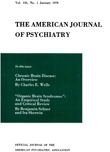THE ROLE OF THE FATHER IN THE FAMILY ENVIRONMENT OF THE SCHIZOPHRENIC PATIENT
Abstract
Study of the personalities of fathers of schizophrenic patients and their roles in the family has shown that few, if any, have filled the paternal role usually expected in middle-and upper-class families, and many exerted seriously pathogenic influences upon the family structure and upon the rearing of the children. There is no one type of father who exerts this deleterious influence and who can properly be termed a schizophrenogenic father; however, we have tentatively grouped these fathers into 3 or 4 categories, a grouping which we realize is not all-inclusive: (1) Fathers of schizophrenic daughters—constantly in battle with their wives who do not fulfill their rigid and distorted expectations, and struggling to gain the daughters to follow their patterns while sabotaging the wives as mothers; (2) fathers who cannot endure the rivalry of a son for the wives' attention and who impede the wives' efforts at mothering while derogating the sons; (3) passive fathers who are nonentities in the home, who do not fill their wives' ideals for a male, and furnish little in the way of acceptable patterns for their sons to follow. Some of this group have never filled the masculine role in the home, while some have failed, lost self-esteem, and left the families for the mothers to guide without support. The role of the mother is not considered in this paper, which seeks only to highlight the difficulties produced by the fathers.
Access content
To read the fulltext, please use one of the options below to sign in or purchase access.- Personal login
- Institutional Login
- Sign in via OpenAthens
- Register for access
-
Please login/register if you wish to pair your device and check access availability.
Not a subscriber?
PsychiatryOnline subscription options offer access to the DSM-5 library, books, journals, CME, and patient resources. This all-in-one virtual library provides psychiatrists and mental health professionals with key resources for diagnosis, treatment, research, and professional development.
Need more help? PsychiatryOnline Customer Service may be reached by emailing [email protected] or by calling 800-368-5777 (in the U.S.) or 703-907-7322 (outside the U.S.).



